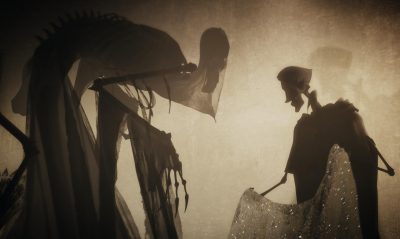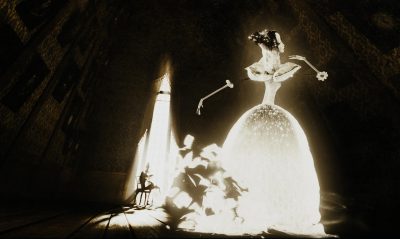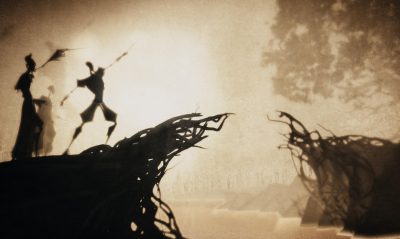One aspect of HP7 Part 1 continuing to receive an incredible amount of praise is the animated ‘Tale of the Three Brothers’ sub-story directed by Ben Hibon and executed by Framestore. fxInsider talks to Hibon how he approached the sequence and making it fit into the Harry Potter universe, in the lead up to the Oscars.
Click here for our interview with Framestore’s sequence supervisor on the animation, Dale Newton
fxg: The thing that I liked the most about the animated sequence was that it felt very part of the film, even though it was animation. How did you approach the production given that it was smack bang in the middle of a live action film?
Hibon: That was always the big question – what should an animation in a Harry Potter film look like? When I sat down with David Yates, it wasn’t so much about discussing references and things like that, it was talking about, ‘What makes Harry Potter such a successful franchise or series?’, ‘Where are those images coming from?’. We were trying to define and get on the same page about would fit with the world and the history and the magical world of Harry Potter.
It was clear to us that we needed to go with a low-fi, very textured, very warm and very simple illustrated world. It was influenced by Eastern European stop-motion kind of animation, including animation by Lotte Reiniger. It had to be there to convey a very universal story – there was no artifice to it that would diverge from what the story should be about. We tried to simplify it to its core, but in filmic terms and cinematographically.
 fxg: So how did you work to make the sequence fit in?
fxg: So how did you work to make the sequence fit in?
Hibon: Why the Harry Potter movies are so good in their story-telling, I think, is that they are so well-told and are very easy to grasp, but they have an attractive and appealing twist to them. We tried to really capture the essence of what a Harry Potter story is and put that in an animated world. In the films and the books, there’s a deep kind of footing in the dark fairy tale world with so much dark magic. That meant that we stuck with that and used the universal imagery of light and shadows. The eerie kind of sceneries and early etching designs were things we looked to. The reference from Lotte came very early on. There is such a craft behind the making of that animation that you never really question its oddness. Some things might not be perfect, but it is not because of the technique – those are creative decisions.
fxg: It also felt more like a 3D animation with a 2D style – was that a conscious decision?
Hibon: When we started talking about Lotte’s work and doing something more 2D-looking and like shadow puppets – which are very 2D techniques – I felt very strongly about not losing the camera work that is part of the overall movie. The camera work is very intricate and if you go through the whole movie and it stops and you feel like you’re being dropped into a 2D world, I felt like you would be taken out of the movie. What 2D is able to do in terms of narration is fairly limited, in the sense that we lose the language of camera. This is where the challenge came of trying to keep that style. We tried to keep the camera moving all the time. I thought it was really important and that you would carry on with the same experience – you’re still getting depth of field and pans and racks. You’re still looking through a lens.
 fxg: Given you were aiming for that look and feel, what was the process of conceptualising the animated sequence?
fxg: Given you were aiming for that look and feel, what was the process of conceptualising the animated sequence?
Hibon: Well, Stuart Craig, the production designer on the Harry Potter series, had done a bunch of research. Then they had some quite edgy illustrations of Death, which was very kind of high-concept art. Then I came in and saw that and loved that. I thought a little bit of life needed to be added to it because they were fairly stoic techniques, but I didn’t want to lose the intricacy and details of these early 2D techniques. I thought what we could try to do is try and play with light and shadows. I’ve always been fascinated with Asian shadow puppetry, so I came back with some of that stuff. I met Dale Newton at Framestore and he straight away had a great grasp on what we needed to achieve. He showed me a couple of tools that would let us play with the light and we basically started developing that look together and going through character design and environment design. I made the storyboards alongside with that, making sure that what we were envisioning was achievable.
fxg: Did you feel like you had to ever pull-back on the technology you were using?
Hibon: I think really we embraced the technology we had at our disposal. No matter how simple things look on screen, they’re still really, really difficult to make. The other thing was we could shuffle things around that you could not normally do when you’re dealing with photorealism and trying to emulate reality. Sometimes you can be confined by those rules and the rules of photography, but here we could completely re-define those rules. We could create our own aesthetic and anything goes, really. But it can be as terrifying as it is thrilling because you really have to know where you’re going and there are so many ways to achieve it. Animation is smoke and mirrors at the end of the day. I’m always very led by the look I’m trying to achieve, but not necessarily the tools. It is always very important that you’re looking at an end-frame and not how beautifully the hair is blowing in the wind. There’s always that danger of being seduced by the amount of sheen you can put on everything.
 fxg: What’s your next project?
fxg: What’s your next project?
Hibon: Here in London I have just signed with Nexus Productions, and we’ve got some great commercials work happening. On the features side, I’ve got an animated feature project called A.D., which is hopefully the first mature animated feature film to come out of Hollywood. There’s a great script by Haylar Garcia which we’ve been working on for quite a while. It’s a survival road movie with zombies, based around some characters trying to survive their new reality. It’s not photoreal and not you’re average Pixar/Dreamworks production, so it sits right in the middle in this big grey area where nobody is making animated movies right now. So hopefully we’ll be the first ones to do that. And we’re also casting for a film called <em>Pan</em> which is a dark fairy tale-like re-invention of the Peter Pan story.
